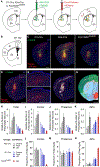Excessive firing of dyskinesia-associated striatal direct pathway neurons is gated by dopamine and excitatory synaptic input
- PMID: 39024096
- PMCID: PMC12080562
- DOI: 10.1016/j.celrep.2024.114483
Excessive firing of dyskinesia-associated striatal direct pathway neurons is gated by dopamine and excitatory synaptic input
Abstract
The striatum integrates dopaminergic and glutamatergic inputs to select preferred versus alternative actions. However, the precise mechanisms underlying this process remain unclear. One way to study action selection is to understand how it breaks down in pathological states. Here, we explored the cellular and synaptic mechanisms of levodopa-induced dyskinesia (LID), a complication of Parkinson's disease therapy characterized by involuntary movements. We used an activity-dependent tool (FosTRAP) in conjunction with a mouse model of LID to investigate functionally distinct subsets of striatal direct pathway medium spiny neurons (dMSNs). In vivo, levodopa differentially activates dyskinesia-associated (TRAPed) dMSNs compared to other dMSNs. We found this differential activation of TRAPed dMSNs is likely to be driven by higher dopamine receptor expression, dopamine-dependent excitability, and excitatory input from the motor cortex and thalamus. Together, these findings suggest how the intrinsic and synaptic properties of heterogeneous dMSN subpopulations integrate to support action selection.
Keywords: CP: Neuroscience; Parkinson's Disease; basal ganglia; dopamine; dyskinesia; electrophysiology; levodopa; optogenetics; striatum.
Copyright © 2024. Published by Elsevier Inc.
Conflict of interest statement
Declaration of interests The authors declare no competing interests.
Figures




References
-
- Gerfen CR, Engber TM, Mahan LC, Susel Z, Chase TN, Monsma FJ Jr., and Sibley DR (1990). D1 and D2 dopamine receptor-regulated gene expression of striatonigral and striatopallidal neurons. Science 250, 1429–1432. - PubMed
-
- Hernandez-Lopez S, Tkatch T, Perez-Garci E, Galarraga E, Bargas J, Hamm H, and Surmeier DJ (2000). D2 dopamine receptors in striatal medium spiny neurons reduce L-type Ca2+ currents and excitability via a novel PLC[beta]1-IP3-calcineurin-signaling cascade. J. Neurosci. 20, 8987–8995. 10.1523/JNEUROSCI.20-24-08987.2000. - DOI - PMC - PubMed
Publication types
MeSH terms
Substances
Grants and funding
LinkOut - more resources
Full Text Sources
Molecular Biology Databases
Miscellaneous

